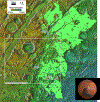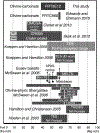Olivine-Carbonate Mineralogy of the Jezero Crater Region
- PMID: 33123452
- PMCID: PMC7592698
- DOI: 10.1029/2019je006011
Olivine-Carbonate Mineralogy of the Jezero Crater Region
Abstract
A well-preserved, ancient delta deposit, in combination with ample exposures of carbonate outcrops, makes Jezero Crater in Nili Fossae a compelling astrobiological site. We use Compact Reconnaissance Imaging Spectrometer for Mars (CRISM) observations to characterize the surface mineralogy of the crater and surrounding watershed. Previous studies have documented the occurrence of olivine and carbonates in the Nili Fossae region. We focus on correlations between these two well-studied lithologies in the Jezero crater watershed. We map the position and shape of the olivine 1 μm absorption band and find that carbonates are found in association with olivine which displays a 1 μm band shifted to long wavelengths. We then use Thermal Emission Imaging Spectrometer (THEMIS) coverage of Nili Fossae and perform tests to investigate whether the long wavelength shifted (redshifted) olivine signature is correlated with high thermal inertia outcrops. We find that there is no consistent correlation between thermal inertia and the unique olivine signature. We discuss a range of formation scenarios for the olivine and carbonate associations, including the possibility that these lithologies are products of serpentinization reactions on early Mars. These lithologies provide an opportunity for deepening our understanding of early Mars and, given their antiquity, may provide a framework to study the timing of valley networks and the thermal history of the Martian crust and interior from the early Noachian to today.
Figures

















References
-
- Amador ES, Bandfield JL, & Thomas NH (2018). A search for minerals associated with serpentinization across Mars using CRISM spectral data. Icarus, 311, 113–134. 10.1016/j.icarus.2018.03.021 - DOI
-
- Baldridge AM, Hook SJ, Crowley JK, Marion GM, Kargel JS, Michalski JL, et al. (2009). Contemporaneous deposition of phyllosilicates and sulfates: Using Australian acidic saline lake deposits to describe geochemical variability on Mars. Geophysical Research Letters, 36, L19201 10.1029/2009GL040069 - DOI
-
- Bishop JL, Lane MD, Dyar MD, & Brown AJ (2008). Reflectance and emission spectroscopy of four groups of phyllosilicates: Smectites, kaolinite-serpentines, chlorites and micas. Clay Minerals, 43(1), 35–54. 10.1180/claymin.2008.043.1.03 - DOI
-
- Bishop JL, Perry KA, Darby Dyar M, Bristow TF, Blake DF, Brown AJ, & Peel SE (2013). Coordinated spectral and XRD analyses of magnesite-nontronite-forsterite mixtures and implications for carbonates on Mars. Journal of Geophysical Research: Planets, 118, 635–650. 10.1002/jgre.20066 - DOI
Grants and funding
LinkOut - more resources
Full Text Sources
Miscellaneous
